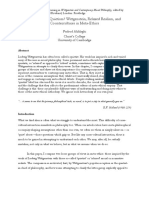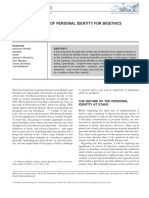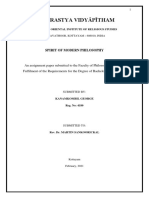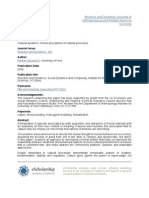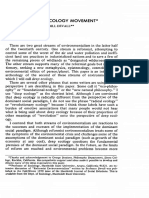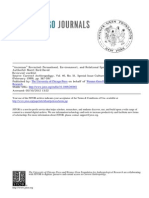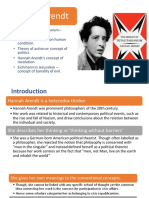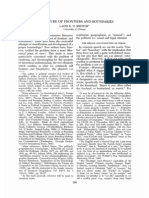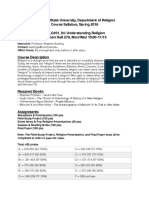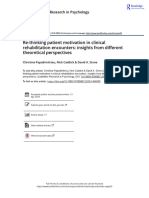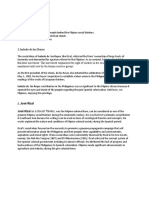Homosexuality and Mental Ilness: Archives of General Psychiatry November 1999
Homosexuality and Mental Ilness: Archives of General Psychiatry November 1999
Uploaded by
Jonathas CostaCopyright:
Available Formats
Homosexuality and Mental Ilness: Archives of General Psychiatry November 1999
Homosexuality and Mental Ilness: Archives of General Psychiatry November 1999
Uploaded by
Jonathas CostaOriginal Title
Copyright
Available Formats
Share this document
Did you find this document useful?
Is this content inappropriate?
Copyright:
Available Formats
Homosexuality and Mental Ilness: Archives of General Psychiatry November 1999
Homosexuality and Mental Ilness: Archives of General Psychiatry November 1999
Uploaded by
Jonathas CostaCopyright:
Available Formats
See discussions, stats, and author profiles for this publication at: https://www.researchgate.
net/publication/12769253
Homosexuality and Mental Ilness
Article in Archives of General Psychiatry · November 1999
DOI: 10.1001/archpsyc.56.10.883 · Source: PubMed
CITATIONS READS
96 3,893
1 author:
J. Michael Bailey
Northwestern University
175 PUBLICATIONS 10,684 CITATIONS
SEE PROFILE
Some of the authors of this publication are also working on these related projects:
Erotic Target Identity Inversions View project
All content following this page was uploaded by J. Michael Bailey on 11 January 2016.
The user has requested enhancement of the downloaded file.
COMMENTARY
Homosexuality and Mental Illness
N
O TOPIC has caused disorder, conduct disorder, and nico- sexual subjects complicates interpre-
the field of psy- tine dependence (odds ratios, 2.8-6.2 tations of the results. For example,
chiatry more con- [compared with the heterosexual sub- perhaps experimentation with ho-
troversy than ho- sample]). mosexuality among heterosexually
mosexuality, and 2 The study by Herrell et al2 used oriented people is associated with im-
articles in this issue of the ARCHIVES a powerful technique: the co-twin pulsivity, and this trait, rather than
are likely to reopen past controver- control method. Specifically, these in- homosexual orientation, is associ-
sies and begin new ones.1,2 These vestigators studied male twins in ated with psychopathology. The de-
studies contain arguably the best which one was homosexual and the cision to label these subjects homo-
published data on the association be- other heterosexual (by the authors’ sexual by the authors was probably
tween homosexuality and psycho- definitions of these respective cat- guided by both constraints on avail-
pathology, and both converge on the egories). It is difficult to imagine how able data (which were not collected
same unhappy conclusion: homo- findings of mental health differ- primarily to study this question) and
sexual people are at a substantially ences between homosexual and het- concerns about statistical power. Re-
higher risk for some forms of emo- erosexual co-twins might be spuri- garding the latter, homosexuality was
tional problems, including suicid- ous. Herrell et al found that gay twins rare even by the lenient behavioral
ality, major depression, and anxi- had higher lifetime rates on 4 mea- definition (2% in the study by Her-
ety disorder. Preliminary results sures of suicidality compared with rell et al2; 3% in the other studies1,3).
from a large, equally well-con- their heterosexual co-twins (odds ra- The low prevalence of homosexual-
ducted Dutch study3 generally cor- tios, 2.4-6.5). (The heterosexual co- ity undoubtedly also was the reason
roborate these findings. twins of homosexual twins scored why Fergusson et al elected to com-
higher on the suicidal indicators com- bine gay men and lesbians into one
METHODOLOGICAL pared with twins from pairs concor- group in their analyses. Most sexual
ADVANCES AND LIMITATIONS dant for heterosexuality, although the orientation researchers believe that
difference was significant for only one the causes of male and female sexual
The strength of the new studies is suicidal symptom.) Results of logis- orientation differ, and if so, the cor-
their degree of control. All too of- tic regression suggested that much, relates may differ as well. Thus, it
ten, prior studies marshaled to ex- but not all, of the increased risk for would be optimal to perform sepa-
amine the mental illness or health suicide among homosexual subjects rate analyses on gay men and lesbi-
of homosexual people used samples was owing to increased depression. ans. For all of these reasons, future
seemingly selected to prove the point Although the new studies rep- studies should be even larger than the
the researchers hoped to make.4 Gay resent notable methodological ad- new ones and should include direct
men undergoing therapy seemed vances compared with most prior measures of sexual orientation.
dysfunctional, while volunteers from research, they also have their limita-
homophile organizations seemed tions. The most important limita- POTENTIAL EXPLANATIONS
well. The current studies are not sus- tion, shared by both studies (as well
ceptible to this criticism. as their Dutch counterpart3), con- Several reactions to the new studies
cerns the definition of homosexual- are predictable. First, some mental
See also pages ity. Both studies included in the defi- health professionals who opposed the
867 and 876 nition of a homosexual person any successful 1973 referendum to re-
subject who had had a same-sex move homosexuality from DSM-III5
The study by Fergusson et al1 fo- sexual experience as an adult. In con- will feel vindicated. Second, some
cused on 1007 children from New trast, homosexual orientation is usu- social conservatives will attribute
Zealand who were observed until the ally assessed by patterns of sexual at- the findings to the inevitable conse-
ageof21years.Thissamplerepresents traction and fantasy. It is conceivable quencesofthechoiceofahomosexual
80% of a birth cohort; hence, results that some of the subjects who had en- lifestyle. Third, and in stark contrast
are exceedingly unlikely to be owing gaged in homosexual behavior were to the other 2 positions, many people
to unrepresentative sampling or dif- not even attracted to people of their will conclude that widespread pre-
ferentialdropout.Subjectswhomthey own sex. For example, 8 of 28 sub- judice against homosexual people
classified as gay, lesbian, or bisexual jects classified as homosexual by Fer- causes them to be unhappy or worse,
were at an increased lifetime risk gusson et al1 labeled themselves het- mentally ill. Commitment to any of
forsuicidalideationandbehavior,ma- erosexual. The problem is that these positions would be premature,
jor depression, generalized anxiety heterogeneity among the homo- however, and should be discouraged.
ARCH GEN PSYCHIATRY/ VOL 56, OCT 1999 WWW.ARCHGENPSYCHIATRY.COM
883
Downloaded from www.archgenpsychiatry.com at Northwestern University, on July 21, 2009
©1999 American Medical Association. All rights reserved.
In fact, a number of potential inter- childhood10 and adulthood.11 The son et al1 and Herrell et al.2 Second,
pretations of the findings need to be most influential etiologic hypoth- it would be a shame—most of all for
considered, and progress toward sci- esis of homosexuality implicates sex- gay men and lesbians whose mental
entific understanding will be achieved atypical levels of prenatal andro- healthisatstake—ifsociopoliticalcon-
only by eliminating competing expla- gens.12,13 Perhaps these influences also cernspreventedresearchersfromcon-
nations. make gay men more susceptible to scientiousconsiderationofanyreason-
Consider first the idea that in- types of psychopathology more com- able hypothesis.
creased depression and suicidality monly found in women and affect les-
among homosexual people are caused bians analogously. This hypothesis is J. Michael Bailey, PhD
by societal oppression. This is an emi- consistent with the association be- Department of Psychology
nently reasonable hypothesis. Surely tween male homosexuality and both Northwestern University
it must be difficult for young people depression and suicidality found by 2029 Sheridan Rd
to come to grips with their homosexu- Herrell et al,2 as well as prior re- Evanston, IL 60208
ality in a world where homosexual ports14 that gay men, like women,
people are often scorned, mocked, score higher on psychological tests of REFERENCES
mourned,andfeared,andthereiscon- neuroticism than heterosexual men.
siderable anecdotal evidence that the It would also imply that gay men
1. Fergusson DM, Horwood LJ, Beautrais AL. Is
“coming out” process is emotionally should have lower rates than hetero- sexual orientation related to mental health prob-
difficult.6 The hypothesis would be sexual men of diagnoses such as an- lems and suicidality in young people? Arch Gen
strengthened by findings that issues tisocial personality disorder, which Psychiatry. 1999;56:876-880.
related to self-acceptance, or accep- more commonly affects men than 2. Herrell R, Goldberg J, True WR, Ramakrishnan V,
tance by others, often trigger homo- women. Lesbians should have oppo- Lyons M, Eisen S, Tsuang MT. Sexual orienta-
tion and suicidality: a co-twin control study in adult
sexualpeople’sdepressiveandsuicidal site vulnerabilities to gay men’s. Un- men. Arch Gen Psychiatry. 1999;56:867-874.
episodes. Furthermore, homosexual fortunately, Fergusson et al,1 who had 3. Sandfort TGM, Graaf Rd, Bijl RV, Schnabel P.
people should not, by this model, be both male and female subjects, did Sexual Orientation and Mental Health: Data from
moresuicidalthanheterosexualpeople not report results separately. the Netherlands Mental Health Survey and Inci-
dence Study (NEMESIS). Stony Brook, NY: Inter-
in reaction to stressors of equal mag- Another possible explanation national Academy of Sex Research; 1999.
nitude. It would indeed be surprising is that increased psychopathology 4. Bayer RB. Homosexuality and American Psychia-
if antihomosexual attitudes were not among homosexual people is a con- try: The Politics of Diagnosis. New York, NY: Ba-
partoftheexplanationofincreasedsui- sequence of lifestyle differences asso- sic Books Inc Publishers; 1981.
cidality among homosexual people, ciated with sexual orientation. For ex- 5. American Psychiatric Association. Diagnostic and
Statistical Manual of Mental Disorders, Third Edi-
but this remains to be demonstrated. ample, gay men are probably not in- tion. Washington, DC: American Psychiatric As-
A second possibility is that ho- nately more vulnerable to the human sociation; 1980.
mosexuality represents a deviation immunodeficiency virus, but some 6. Isay R. Becoming Gay: The Journey to Self-
from normal development and is as- have been more likely to become in- Acceptance. New York, NY: Pantheon Books; 1996.
7. Thornhill R, Moller AP. Developmental stability,
sociated with other such deviations fected because of 2 behavioral risk fac-
disease and medicine. Biol Rev Camb Philos Soc.
that may lead to mental illness. One tors associated with male homosexu- 1997;72:497-548.
need not believe that homosexuality ality: receptive anal sex and promis- 8. Lindesay J. Laterality shift in homosexual men.
is a psychopathologic trait (ie, a be- cuity. It is unclear how an analogous Neuropsychologia. 1987;25:965-969.
havioral or emotional trait that nec- model would account for homosexual 9. McCormick CM, Witelson SF, Kingstone E. Left-
handedness in homosexual men and women: neu-
essarily creates problems for the in- people’s increased rates of suicidality roendocrine implications. Psychoneuroendocri-
dividual or for society) to believe that and depression, although at least one nology. 1990;15:69-76.
evolution has worked to ensure het- otherdisordermaybeexplicableinthis 10. Bailey JM, Zucker KJ. Childhood sex-typed behav-
erosexualityinmostcasesandthatho- way.Gaymenappeartobevastlyover- ior and sexual orientation: a conceptual analysis and
mosexuality may represent a develop- represented among male patients with quantitative review. Dev Psychol. 1995;31:43-55.
11. Lippa RA. Gender-related traits in gay men, les-
mental error. This hypothesis would eating disorders.15 One explanation is bians, and heterosexual men and women: the vir-
be supported by findings that homo- that the gay male culture emphasizes tual identity of homosexual-heterosexual diag-
sexual people (and people disposed physical attractiveness and thinness, nosticity and gender diagnosticity. J Pers. In press.
to suicidality and depression) have just as the heterosexual culture em- 12. Byne W, Parsons B. Human sexual orientation: the
biologic theories reappraised. Arch Gen Psychia-
higher rates of indicators of develop- phasizesfemalephysicalattractiveness
try. 1993;50:228-239.
mental instability, such as fluctuating and thinness.16 13. Meyer-Bahlburg HFL. Psychoendocrine research on
asymmetry, left-handedness, and mi- It is unlikely that any one of these sexual orientation: current status and future op-
nor physical anomalies.7 Although re- models will explain all of the differ- tions. In: Vries GJD, Bruin JPCD, Uylings HBM, Cor-
search has linked left-handedness to encesinthepsychopathologybetween ner MA, eds. Sex Differences in the Brain. New York,
NY: Elsevier Science Inc; 1984:375-398.
both male8 and female9 sexual orien- homosexual and heterosexual people. 14. Van den Aardweg GJ. Male homosexuality and the
tation, considerably more research Perhaps social ostracism causes gay neuroticism factor: an analysis of research out-
wouldbenecessarytovalidatethegen- menandlesbianstobecomedepressed, come. Dynamic Psychother. 1985;3:79-87.
eral hypothesis. but why would it cause gay men to 15. Carlat DJ, Camargo CA Jr. Review of bulimia ner-
Another developmental hypoth- have eating disorders? Two things are vosa in males. Am J Psychiatry. 1991;148:831-843.
16. Siever MD. Sexual orientation and gender as fac-
esis concerns gender. On average, ho- certain, however. First, more research tors in socioculturally acquired vulnerability to body
mosexual people are sex-atypical with is needed to understand the fascinat- dissatisfaction and eating disorders. J Consult Clin
respect to some traits, both during ing and important findings of Fergus- Psychol. 1994;62:252-260.
ARCH GEN PSYCHIATRY/ VOL 56, OCT 1999 WWW.ARCHGENPSYCHIATRY.COM
884
Downloaded from www.archgenpsychiatry.com at Northwestern University, on July 21, 2009
©1999 American Medical Association. All rights reserved.
View publication stats
You might also like
- Health Education Behavior Models and Theories - PPTDocument55 pagesHealth Education Behavior Models and Theories - PPTJonah R. Merano93% (14)
- Analyzing Oppression - Cudd, Ann E., 1959 - 2006 - New York - Oxford University Press - 9780195187434 - Anna's ArchiveDocument300 pagesAnalyzing Oppression - Cudd, Ann E., 1959 - 2006 - New York - Oxford University Press - 9780195187434 - Anna's Archiveratyanshgarg2005100% (1)
- Susan Petrilli y Augusto Ponzio - Semiotics TodayDocument99 pagesSusan Petrilli y Augusto Ponzio - Semiotics TodayTavarishNo ratings yet
- Alexander, Brewer & Herrmann, 1999 PDFDocument16 pagesAlexander, Brewer & Herrmann, 1999 PDFBruno Filipe CoelhoNo ratings yet
- Descartes' Embodied Psychology: Descartes' or Damasio's Error?Document20 pagesDescartes' Embodied Psychology: Descartes' or Damasio's Error?b100% (1)
- Byrne 1961Document3 pagesByrne 1961Dred ZerozNo ratings yet
- The Innate-Immutable Argument Finds No Basis in ScienceDocument5 pagesThe Innate-Immutable Argument Finds No Basis in ScienceDr. Momin SohilNo ratings yet
- Ecological ApproachDocument4 pagesEcological Approachapi-19812879No ratings yet
- History of PsychologyDocument21 pagesHistory of PsychologyMelanySantanaNo ratings yet
- Thrift (2008) Where Is The Subject?Document8 pagesThrift (2008) Where Is The Subject?Nico SanhuezaNo ratings yet
- Cultural Relativism': Human Rights QuarterlyDocument47 pagesCultural Relativism': Human Rights QuarterlyLixo ElectronicoNo ratings yet
- On The Origin of Everything - A Universe From NothingDocument4 pagesOn The Origin of Everything - A Universe From NothingSyed Fateh AlamNo ratings yet
- Priest, p.27-190 PDFDocument194 pagesPriest, p.27-190 PDFPatrícia Da Silva PinheiroNo ratings yet
- Equality of Whom?Document18 pagesEquality of Whom?Gabriela Castillo QuintanillaNo ratings yet
- Meta-Ethical Quietism? Wittgenstein, Relaxed Realism, and Countercultures in Meta-Ethics Farbod AkhlaghiDocument32 pagesMeta-Ethical Quietism? Wittgenstein, Relaxed Realism, and Countercultures in Meta-Ethics Farbod AkhlaghiNick Purches-KnabNo ratings yet
- Blackmore - What Is It Like To BeDocument14 pagesBlackmore - What Is It Like To BeDibi Lorena Guzmán CalderónNo ratings yet
- Williams - What Is It Like To Be Unconscious - Draft VersionDocument34 pagesWilliams - What Is It Like To Be Unconscious - Draft VersionOrestesMantra100% (1)
- Secular Humanist ThoughtsDocument3 pagesSecular Humanist ThoughtsSally MoremNo ratings yet
- Islam ExplainedDocument125 pagesIslam ExplainedPddfNo ratings yet
- Restoration of Political Science (Karl Ludwig Von Haller) (Z-Library)Document321 pagesRestoration of Political Science (Karl Ludwig Von Haller) (Z-Library)Shahnawaz JadoonNo ratings yet
- On The Human - Rethinking The Natural Selection of Human Language by Terrence W. DeaconDocument40 pagesOn The Human - Rethinking The Natural Selection of Human Language by Terrence W. DeaconlapaupierenoireNo ratings yet
- The University of Chicago PressDocument6 pagesThe University of Chicago PressMartin CothranNo ratings yet
- The Racist Mind in SocietyDocument22 pagesThe Racist Mind in SocietyHassan Ansah100% (2)
- Why Am I Me and Not Someone Else.Document15 pagesWhy Am I Me and Not Someone Else.Tim KlaassenNo ratings yet
- Identity Politics and the New Genetics: Re/Creating Categories of Difference and BelongingFrom EverandIdentity Politics and the New Genetics: Re/Creating Categories of Difference and BelongingNo ratings yet
- Rethinking Vulnerability and Resistance Judith Butler PDFDocument19 pagesRethinking Vulnerability and Resistance Judith Butler PDFJuliana Farias100% (1)
- Vigilantism, 1937Document8 pagesVigilantism, 1937rcarrozza427015No ratings yet
- Marsh Melville Moral Panics and The British Media March 2011Document21 pagesMarsh Melville Moral Panics and The British Media March 2011Saša PerovićNo ratings yet
- CH 4 Notes Sensation and PerceptionDocument99 pagesCH 4 Notes Sensation and Perceptionapi-261300427No ratings yet
- John Tooby Department of Anthropology Harvard University: The Emergence of Evolutionary PsychologyDocument6 pagesJohn Tooby Department of Anthropology Harvard University: The Emergence of Evolutionary PsychologyleohellNo ratings yet
- The Insignificance of Personal Identity For Bioethics - David ShoemakerDocument9 pagesThe Insignificance of Personal Identity For Bioethics - David ShoemakerJonatas TaimonNo ratings yet
- Martha Nussbaum - Human FunctioningDocument46 pagesMartha Nussbaum - Human FunctioningBernardoBrandaoNo ratings yet
- The Multiregional Evolution of HumansDocument8 pagesThe Multiregional Evolution of HumansDariebel Sab-it100% (1)
- Sex Differences in The Brain The Not So Inconvenient TruthDocument7 pagesSex Differences in The Brain The Not So Inconvenient TruthAlejandro VegaNo ratings yet
- Parfit - Personal Identity and RationalityDocument15 pagesParfit - Personal Identity and RationalityAlma Rosa Garza100% (1)
- Incarnation and Digitization Marshall MCDocument17 pagesIncarnation and Digitization Marshall MCjoaquincardosoNo ratings yet
- Emanuel R - Thalamic FearDocument11 pagesEmanuel R - Thalamic FearrussNo ratings yet
- 7 Pillars of Stat Wisdom PDFDocument38 pages7 Pillars of Stat Wisdom PDFreub33No ratings yet
- Anomie IngentaDocument14 pagesAnomie IngentaMike ShakespeareNo ratings yet
- Dawkins and Biological DeterminismDocument4 pagesDawkins and Biological Determinismdennistrillo100% (1)
- The Spandrels of San Marco and The Pang PDFDocument7 pagesThe Spandrels of San Marco and The Pang PDFSebastián LomelíNo ratings yet
- Spirit of Modern Philosophy JesDocument10 pagesSpirit of Modern Philosophy JesJes ShibuNo ratings yet
- American LynchingDocument29 pagesAmerican Lynchingalagemo100% (2)
- 2008 - Fischer - Cultural Dynamics - Structure and DynamicsDocument18 pages2008 - Fischer - Cultural Dynamics - Structure and DynamicsMichael Fischer100% (1)
- 05 Devall DeepDocument24 pages05 Devall DeepjoshBenNo ratings yet
- Update On Proprioception: Considerations For Dance EducationDocument8 pagesUpdate On Proprioception: Considerations For Dance EducationAna Carolina PetrusNo ratings yet
- Bird-David, Nurit. 1999. Animism Revisited - Personhood, Environment, and Relational EpistemologyDocument27 pagesBird-David, Nurit. 1999. Animism Revisited - Personhood, Environment, and Relational EpistemologyAmanda HortaNo ratings yet
- The Ordinariness of EvilDocument11 pagesThe Ordinariness of EvilGelky ArveloNo ratings yet
- The Evolution of Cultural Evolution: ArticlesDocument13 pagesThe Evolution of Cultural Evolution: ArticlesRok SilmariNo ratings yet
- 2011 The Role of The Self in Mindblindness in AutismDocument11 pages2011 The Role of The Self in Mindblindness in AutismRik LameschNo ratings yet
- Hannah ArendtDocument15 pagesHannah ArendtRohit KumarNo ratings yet
- Beyond MisinformationDocument17 pagesBeyond Misinformationinno dan100% (1)
- Barsalou - Grounded CognitionDocument32 pagesBarsalou - Grounded CognitionEckart ZimmermannNo ratings yet
- Latour - Ramses Died of TuberculosisDocument25 pagesLatour - Ramses Died of TuberculosisEmmanuel AlvesNo ratings yet
- Agnew, Robert - General Strain Theory PDFDocument16 pagesAgnew, Robert - General Strain Theory PDFMduduzi Eric ZikaliNo ratings yet
- Sources For Forced Sterilization and Eugenics Program NHD NationalsDocument27 pagesSources For Forced Sterilization and Eugenics Program NHD Nationalsapi-453652237No ratings yet
- Kekes Meaningof LifeDocument19 pagesKekes Meaningof LifeMichael TheodoreNo ratings yet
- AAAG1959 - The Nature of Frontiers and Boundaries (Ladis Kristof)Document14 pagesAAAG1959 - The Nature of Frontiers and Boundaries (Ladis Kristof)leticiaparenterNo ratings yet
- The Meaning of Independence DayDocument285 pagesThe Meaning of Independence DayCheryl MillerNo ratings yet
- Understanding Religion Spring 2018 SyllabusDocument6 pagesUnderstanding Religion Spring 2018 SyllabusstephenmkNo ratings yet
- LDMs Monitoring Tool For SH and PSDSDocument4 pagesLDMs Monitoring Tool For SH and PSDSdel420No ratings yet
- Pengaruh Bermain Peran Terhadap Peningkatan Kemampuan Sosial Anak Usia DiniDocument14 pagesPengaruh Bermain Peran Terhadap Peningkatan Kemampuan Sosial Anak Usia DiniYusni III BNo ratings yet
- The Forbidden Female Speaks: The Story of One Peter CleagueDocument25 pagesThe Forbidden Female Speaks: The Story of One Peter CleagueVictor CătălinNo ratings yet
- Influence of School Heads' Leadership Styles On Students' Academic Performance in Public Secondary Schools in Nyamagana District, Mwanza, TanzaniaDocument14 pagesInfluence of School Heads' Leadership Styles On Students' Academic Performance in Public Secondary Schools in Nyamagana District, Mwanza, TanzaniaIJELS Research Journal100% (1)
- San Antonio de Padua College Foundation of Pila, Laguna IncDocument1 pageSan Antonio de Padua College Foundation of Pila, Laguna IncJanelyn GarinNo ratings yet
- Hand Out 5,6Document3 pagesHand Out 5,6ይርዳው ሲሳይ ወርቀልዑልNo ratings yet
- Leadership Traits & Skills: APAMSA Leadership Development ModuleDocument22 pagesLeadership Traits & Skills: APAMSA Leadership Development ModuleDeepmallya BhattacharjeeNo ratings yet
- Conversation As A Discourse TypeDocument22 pagesConversation As A Discourse TypeNatalia PetiyNo ratings yet
- Hello!: Welcome To Our English Class!Document37 pagesHello!: Welcome To Our English Class!Hazel Mae HerreraNo ratings yet
- Blechner MJ The Role of Prejudice in Psychopathology and Psychoanalytic History p239 250Document12 pagesBlechner MJ The Role of Prejudice in Psychopathology and Psychoanalytic History p239 250ÇınarNo ratings yet
- Qualitative ResearchDocument46 pagesQualitative ResearchDasilvaz JuniorNo ratings yet
- A Study of Family Relationship in Relation To Emotional Intelligence On Grade 9 Students of San Basilio High SchoolDocument12 pagesA Study of Family Relationship in Relation To Emotional Intelligence On Grade 9 Students of San Basilio High SchoolMark Louise Calilung PonceNo ratings yet
- Bonsai Tree LessonDocument2 pagesBonsai Tree Lessonapi-525048974No ratings yet
- mAESRSK nOTESDocument1 pagemAESRSK nOTESAnurag DwivediNo ratings yet
- Bl018 Walshe Buddhist-TherapyDocument25 pagesBl018 Walshe Buddhist-TherapyMartin ChowdhuryNo ratings yet
- Common Rating Scale Errors: Leniency ErrorDocument2 pagesCommon Rating Scale Errors: Leniency ErrorMary Grace RaganasNo ratings yet
- Grade-11-Philo - Q1 Mod 2 Method of Philospphizing v3Document25 pagesGrade-11-Philo - Q1 Mod 2 Method of Philospphizing v3Maria Fe Vibar100% (1)
- GAD Topic 1. Promoting Gender Responsive Management and Transformative LeadershipDocument3 pagesGAD Topic 1. Promoting Gender Responsive Management and Transformative LeadershipJohn WickNo ratings yet
- Chapter 8Document23 pagesChapter 8fahmy riyantiNo ratings yet
- Learning Environment Refers To The Diverse Physical Locations, Contexts, andDocument7 pagesLearning Environment Refers To The Diverse Physical Locations, Contexts, andApril Rose Salvadico100% (1)
- Work Stress and Health in A Globalized Economy. The Model of Effort-Reward ImbalanceDocument384 pagesWork Stress and Health in A Globalized Economy. The Model of Effort-Reward ImbalanceBeaHm100% (1)
- Organizational Change: Perspectives On Theory and Practice: Chapter 1: IntroductionDocument12 pagesOrganizational Change: Perspectives On Theory and Practice: Chapter 1: IntroductionAisha ShafiqNo ratings yet
- Elements of MBODocument3 pagesElements of MBOMarlon Reyes100% (1)
- Lesson 4Document5 pagesLesson 4api-547693363No ratings yet
- Filipino Social Thinkers Objectives:: 1.isabelo de Los ReyesDocument7 pagesFilipino Social Thinkers Objectives:: 1.isabelo de Los ReyesVJ JucutanNo ratings yet
- Social IsolationDocument2 pagesSocial IsolationFlos Carmeli MontanaNo ratings yet
- Quiz 4 - Even & Online Hamnah Lateef 221-437046Document4 pagesQuiz 4 - Even & Online Hamnah Lateef 221-437046hamnah lateefNo ratings yet
- Mil - Act - Types of CommunicationDocument22 pagesMil - Act - Types of CommunicationSyrah Lou BadaranNo ratings yet
- Child Observation MethodsDocument1 pageChild Observation MethodsLexy AnnNo ratings yet














